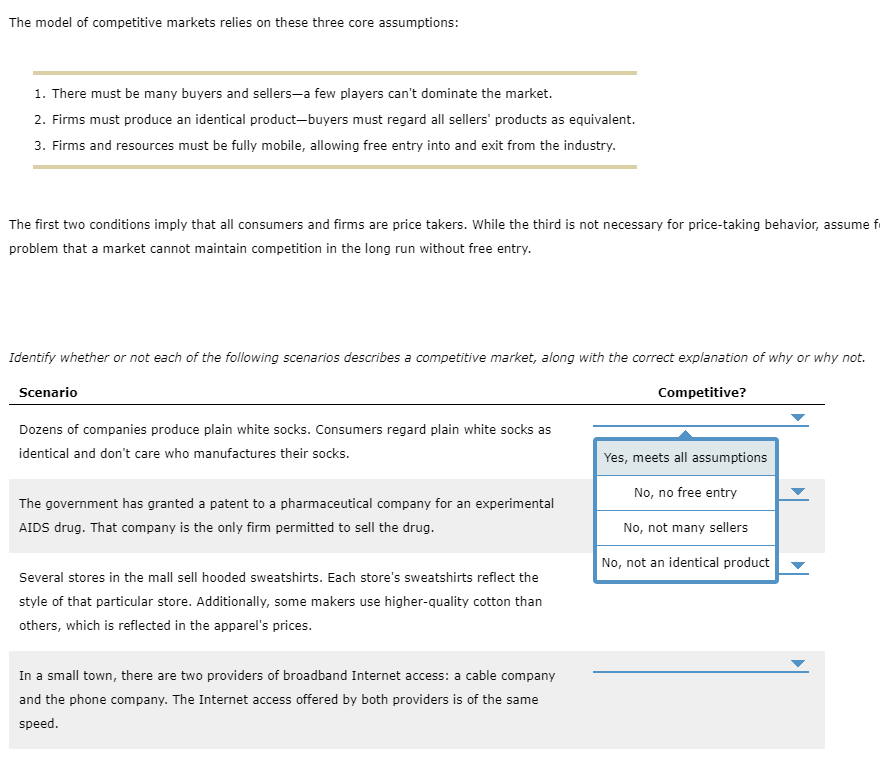The model of competitive markets relies on these three core assumptions: 1. There must be many buyers and sellers-a few players can't dominate the market. 2. Firms must produce an identical product-buyers must regard all sellers' products as equivalent. 3. Firms and resources must be fully mobile, allowing free entry into and exit from the industry. The first two conditions imply that all consumers and firms are price takers. While the third is not necessary for price-taking behavior, assume problem that a market cannot maintain competition in the long run without free entry. Identify whether or not each of the following scenarios describes a competitive market, along with the correct explanation of why or why not. Scenario Competitive? Dozens of companies produce plain white socks. Consumers regard plain white socks as identical and don't care who manufactures their socks. Yes, meets all assumptions No, no free entry The government has granted a patent to a pharmaceutical company for an experimental AIDS drug. That company is the only firm permitted to sell the drug. No, not many sellers No, not an identical product Several stores in the mall sell hooded sweatshirts. Each store's sweatshirts reflect the style of that particular store. Additionally, some makers use higher-quality cotton than others, which is reflected in the apparel's prices.
The model of competitive markets relies on these three core assumptions: 1. There must be many buyers and sellers-a few players can't dominate the market. 2. Firms must produce an identical product-buyers must regard all sellers' products as equivalent. 3. Firms and resources must be fully mobile, allowing free entry into and exit from the industry. The first two conditions imply that all consumers and firms are price takers. While the third is not necessary for price-taking behavior, assume problem that a market cannot maintain competition in the long run without free entry. Identify whether or not each of the following scenarios describes a competitive market, along with the correct explanation of why or why not. Scenario Competitive? Dozens of companies produce plain white socks. Consumers regard plain white socks as identical and don't care who manufactures their socks. Yes, meets all assumptions No, no free entry The government has granted a patent to a pharmaceutical company for an experimental AIDS drug. That company is the only firm permitted to sell the drug. No, not many sellers No, not an identical product Several stores in the mall sell hooded sweatshirts. Each store's sweatshirts reflect the style of that particular store. Additionally, some makers use higher-quality cotton than others, which is reflected in the apparel's prices.
Microeconomics: Private and Public Choice (MindTap Course List)
16th Edition
ISBN:9781305506893
Author:James D. Gwartney, Richard L. Stroup, Russell S. Sobel, David A. Macpherson
Publisher:James D. Gwartney, Richard L. Stroup, Russell S. Sobel, David A. Macpherson
Chapter3: Demand, Supply, And The Market Process
Section: Chapter Questions
Problem 16CQ
Related questions
Question
100%

Transcribed Image Text:The model of competitive markets relies on these three core assumptions:
1. There must be many buyers and sellers-a few players can't dominate the market.
2. Firms must produce an identical product-buyers must regard all sellers' products as equivalent.
3. Firms and resources must be fully mobile, allowing free entry into and exit from the industry.
The first two conditions imply that all consumers and firms are price takers. While the third is not necessary for price-taking behavior, assume f
problem that a market cannot maintain competition in the long run without free entry.
Identify whether or not each of the following scenarios describes a competitive market, along with the correct explanation of why or why not.
Scenario
Competitive?
Dozens of companies produce plain white socks. Consumers regard plain white socks as
identical and don't care who manufactures their socks.
Yes, meets all assumptions
No, no free entry
The government has granted a patent to a pharmaceutical company for an experimental
AIDS drug. That company is the only firm permitted to sell the drug.
No, not many sellers
No, not an identical product
Several stores in the mall sell hooded sweatshirts. Each store's sweatshirts reflect the
style of that particular store. Additionally, some makers use higher-quality cotton than
others, which is reflected in the apparel's prices.
In a small town, there are two providers of broadband Internet access: a cable company
and the phone company. The Internet access offered by both providers is of the same
speed.
Expert Solution
This question has been solved!
Explore an expertly crafted, step-by-step solution for a thorough understanding of key concepts.
This is a popular solution!
Trending now
This is a popular solution!
Step by step
Solved in 4 steps

Knowledge Booster
Learn more about
Need a deep-dive on the concept behind this application? Look no further. Learn more about this topic, economics and related others by exploring similar questions and additional content below.Recommended textbooks for you

Microeconomics: Private and Public Choice (MindTa…
Economics
ISBN:
9781305506893
Author:
James D. Gwartney, Richard L. Stroup, Russell S. Sobel, David A. Macpherson
Publisher:
Cengage Learning

Economics: Private and Public Choice (MindTap Cou…
Economics
ISBN:
9781305506725
Author:
James D. Gwartney, Richard L. Stroup, Russell S. Sobel, David A. Macpherson
Publisher:
Cengage Learning

Macroeconomics: Private and Public Choice (MindTa…
Economics
ISBN:
9781305506756
Author:
James D. Gwartney, Richard L. Stroup, Russell S. Sobel, David A. Macpherson
Publisher:
Cengage Learning

Microeconomics: Private and Public Choice (MindTa…
Economics
ISBN:
9781305506893
Author:
James D. Gwartney, Richard L. Stroup, Russell S. Sobel, David A. Macpherson
Publisher:
Cengage Learning

Economics: Private and Public Choice (MindTap Cou…
Economics
ISBN:
9781305506725
Author:
James D. Gwartney, Richard L. Stroup, Russell S. Sobel, David A. Macpherson
Publisher:
Cengage Learning

Macroeconomics: Private and Public Choice (MindTa…
Economics
ISBN:
9781305506756
Author:
James D. Gwartney, Richard L. Stroup, Russell S. Sobel, David A. Macpherson
Publisher:
Cengage Learning